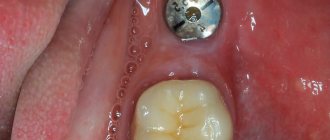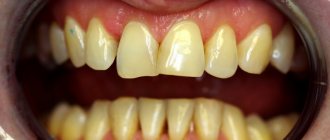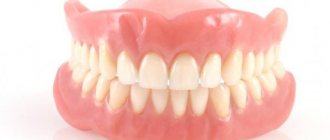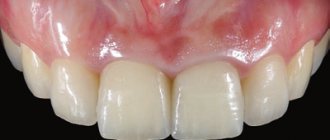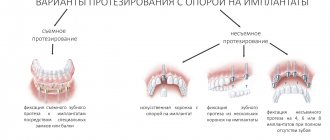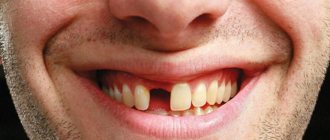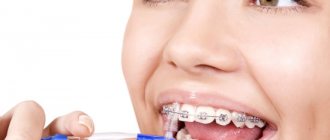What are crown + root modules?
Previously, in the case of complete destruction of the front tooth, but with the presence of a healthy root, the crown was attached to a pin - now pins are a thing of the past and are replaced by a single CEREC module “crown + root”
When restoring three or four consecutive front teeth, we can recommend the installation of a bridge-like orthopedic structure - a fused connection of several crowns. But many patients choose separate crowns for each tooth, which are not only more practical, but also look more aesthetically pleasing.
What prostheses can be placed in the smile zone - the most complete list of solutions and their features
Article navigation
- Indications for prosthetics
- Important Features
- Prosthetic options
- Removable prosthetics
- Fixed dentures
- Implantation of incisors and canines
- Which dentures are better?
- Which material to choose
- In what situations is enamel grinding not necessary?
- Periodontitis and periodontal disease
- Contraindications
- Dentists' recommendations
- Price
Question for a specialist
People practically do not use incisors for chewing food, which is why when restoring them, high demands are placed mainly only on aesthetics and restoration of the correct bite. It is very important that your smile looks natural and natural. However, the material must still be strong enough to withstand the average load of biting food. Because of all these features, prosthetics of the front teeth contains many nuances, which will be discussed further.
Indications for prosthetics in the smile area
When thinking about prosthetics for the upper or lower front teeth, you need to know in what cases it is necessary. It is clear that the complete absence of an incisor or canine tooth along with the root is a direct indication for prosthetics. But there are other cases when it is a prosthesis in the classical sense that is needed, and not a filling. Let's look at the main indications for prosthetics in the smile area:
- chipped crown: the defect is more than half of its original size,
- cracks in the enamel or its abrasion,
- malocclusion: only in case of minor pathologies it is corrected with dentures, otherwise braces/aligners (orthodontic aligners) are needed,
- frequent caries under fillings,
- enamel defects: darkening, smoker’s plaque, “tetracycline” staining, fluorosis, thin enamel layer,
- complete absence of a tooth along with the root.
That is, prosthetics are necessary to recreate the aesthetics and functionality of a smile, as well as to create a more attractive appearance. The latter is especially true for public people and women.
Tooth extraction under sedation
Some teeth could not be treated. Removal of failing teeth was even necessary to stop the inflammatory process and bone loss.
Tooth extraction under sedation relieves stress and increased blood pressure. The patient is in a state of medical sleep while the teeth are removed and sutures are applied, and after the operation he quickly comes to his senses, without unpleasant memories. The operation lasted 1 hour.
Two weeks after the teeth were removed, the condition of the gums improved noticeably.
Important features of restoration of incisors and canines
Features of prosthetics of the anterior teeth of the lower and upper jaw are as follows:
- it is important to recreate the aesthetics of the smile and face: choose the right shape and color of dentures that are identical to the enamel of neighboring units of the dentition,
- it is important to pay attention to the position of the gums: the contour of the mucous membrane should be natural and natural,
- it is important to ensure good fixation of the prosthesis: so that a person can not only smile, but also bite and chew food normally (although biting off very hard foods will no longer be possible in any case),
- It is important that the restoration does not cause discomfort and does not provoke pathologies: allergies or inflammation.
Only until 15.01 South Korean implant Osstem - from 18,500 rubles.
Hurry up to sign up for a free consultation and lock in promotional prices.
Call now or request a call
Opening hours: 24 hours a day - seven days a week
Removable prosthetics and its features
- When to use: if one or more front teeth are missing along with the roots, that is, they are completely removed.
The peculiarity of removable dentures is that they are fixed to the supporting teeth with hooks (clasps). These clasps are noticeable when you smile (if the hooks are made of metal) or often become loose and break (if the clasps are made of plastic). The attachments can damage the enamel of the supports or the surrounding gums, causing inflammation. By the way, this can also include a rapid decline in aesthetics, because plastic teeth quickly darken from plaque, and it will not be possible to whiten them to an ideal state.
Most often, a removable butterfly prosthesis is placed on the front teeth (if the chewing ones are preserved) - and only as a temporary solution. In other cases, in order to also partially restore the chewing teeth, you will have to make a massive prosthesis with a voluminous plastic palate or gum - this way it will hold better, but with less comfort.
In orthopedic dentistry, there are the following types of removable dentures:
- acrylic: made of long-known and inexpensive acrylic plastic,
- Acry-free (“Acry-free”): a modern variation of the previous type. Made from plastic that contains virtually no acrylic monomer (somewhat a toxic substance found in conventional acrylics),
- polyurethane: Russian alternative to nylon structures. The material is soft and flexible,
- clasp: unlike all the others, clasps have a metal arch, which adds rigidity and more correctly distributes the chewing load. The upper palate is not made solid, but in the form of a small bridge, which increases wearing comfort. Clasp ones will be placed only if at least part of the lateral teeth is missing, otherwise they simply cannot be fixed,
- Quattro Ti (“Quadrotti”): similar to clasp ones in structure and scope, but “Quadrotti” do not have a metal arc. They are made only from Dental D material (a combination of nylon and plastic), patented by Quattro Ti.
To read about each individual type of prosthesis, click on the name to go to the corresponding page with a description.
Fixed dentures to restore the smile area
- When to use: if teeth have lost their aesthetics, are partially destroyed, there are chips - these are indications for installing veneers or crowns. If the teeth are missing along with the roots, then bridges are placed.
Fixed ones correspond to almost all features of prosthetics, since they are highly aesthetic, are well fixed, and the absence of plastic gums and palate makes wearing them quite comfortable. But all this provided that an experienced orthopedist was involved in the prosthetics, high-quality materials and technological equipment were used.
%akc72%
The advantage of non-removable ones is that they last much longer than removable ones. Fixed ones do not move, they do not need to be taken out of the mouth to clean (and the person will not forget to put them back), they do not need to be glued to the cream, and there is no need to get used to a foreign object in the mouth. The disadvantages include the cost, which is significantly higher than that of removable ones.
Aesthetic prosthetics – veneers, lumineers, ultraneers
Veneers, lumineers and ultraneers are durable and aesthetic microprostheses for the smile area; they are installed only on the front part of the dentition and mask minor defects, creating a “Hollywood smile”. They can cover cracks in the enamel, small chips, interdental spaces (diastemas and trema), and slightly level the inclination of the teeth.
Veneers (in fact, lumineers and ultraneers are also veneers) are presented in the form of thin ceramic overlays. Their thickness varies between 0.3-0.6 mm. And if ultraneers are just thin veneers (0.3 mm), then lumineers are already a patented brand with its own manufacturing technology (the thickness of lumineers is about 0.2 mm). You can evaluate the aesthetics of lumineers restoration using photos before and after prosthetics of the front teeth.
Among the positive aspects of veneers are the highest aesthetics and durability (10-20 years of trouble-free wear). The disadvantages include very careful operation of the restoration, high cost, and the need to install 6-8 veneers or lumineers per row at once. But in the case of classic veneers, it is possible to replace one or two front teeth.
Traditional prosthetics with crowns
If the top is destroyed by more than half, but the roots are intact, it is recommended to use dental crowns.
A crown is a cap-shaped prosthesis that restores a single defect and is placed on some kind of support. It perfectly follows the shape of the natural tooth apex and is fixed very firmly with special cement. But it is rarely possible to remove a crown without damaging it, for example, to treat root canals or periodontitis. In this case, you have to make a new one. And after several removals/fixations, a situation often arises that the root has to be removed (if it is severely damaged due to caries or frequent treatment). Then it is no longer possible to install a crown; you have to look for other prosthetic options.
To fix the crowns, a certain support is required:
- the preserved part of the natural tooth apex: it is previously ground down to give the shape of a stump or a truncated cone,
- post: a metal screw that is secured into the tooth root. The advantages of the method are low price, the disadvantages are uneven load on the root, insufficient fastening reliability,
- stump tab: a more successful (but also expensive) analogue to a pin. The inlay can be made of durable metal-free materials, the shape exactly follows the cavity inside the root and rises above the gum so that the crown can be fixed to it. Metal-free materials transmit light in a similar way to natural tooth enamel. This option looks more aesthetically pleasing and will last many times longer than pins.
Bridges
They are used when 1-4 teeth are missing in a row. A necessary condition is the presence of supports (or their healthy roots) along the edges of the defect.
Bridges (or bridges) are several crowns connected in a row. Bridges differ from single crowns in that they do not have holes at the bottom and rest on the gums, and the outer ones are created for fixation on supports. Also, “wings” – located along the edges of the bridge – can be attached to these supports.
Adhesive bridges1 have just such “wings”. These bridges are temporary, but are fixed quite reliably (they can come off due to chewing gum or very hard food). The installation can be performed on children and adults - on a temporary basis while awaiting implantation, for example.
The advantages of bridges include high aesthetics, long-term fixation and comfortable operation. But they have a very big drawback - the need to grind down the supports and remove their “dental nerves”. These factors, plus additional chewing load, lead to rapid failure of the supports. You have to re-treat them, and eventually remove them - and each time you need to redo the bridges or make new ones. As a result, when the defect becomes very extensive, you will have to completely abandon bridges in favor of other types of prosthetics.
Another significant disadvantage is that when wearing bridges (as well as removable structures), the bone will constantly atrophy under the plastic base or “empty” crowns. Along with the bone, the gums also recede, making the smile unattractive and allowing food to accumulate in the space between the denture and the gums. After every few months of wearing it, you have to go to an orthopedist and adjust the displaced prosthesis.
Dental restoration methods
The clinics of the Amazing Prices Dentistry network in Moscow use materials for prosthetics of front teeth that ideally reflect the shape and color of natural enamel. Even the most difficult cases of chipped, abnormally pigmented or broken teeth can be easily corrected with one of the following methods to restore a beautiful smile.
- Veneers
The most beautiful restorations of the front teeth are performed with veneers. These are microprostheses in the form of thin ceramic overlays that are attached to the outside of the teeth. Thanks to the diffusion of natural light into the ceramic layer, the teeth look exceptionally natural. Veneers can be used if the enamel is sufficient in quantity and quality. This method is designed to hide a wide variety of dental damage. It is important to understand that veneers are installed in a complex - eight (minimum six) overlays for each row of teeth. Therefore, if the problem is with just one tooth, this option is not always advisable to use. Any malocclusions, tooth decay, or gingivitis must be treated before veneers are placed. It is also recommended to whiten your teeth before prosthetics using veneers.
- Single crown
Restoring a tooth after root canal treatment or a fracture of the coronal part can be performed using a single prosthesis - a crown. It covers the tooth, restores its natural appearance, strengthens it and provides the same comfort as natural teeth. The material you can choose is solid ceramics - the best option for prosthetics of front teeth, premium zirconium dioxide or standard metal ceramics. Crowns made of solid ceramics are very aesthetic and therefore are often used in dentistry to restore the frontal area.
- Bridge prosthetics
Another popular direction in dental practice, which is used if the front tooth has fallen out or been removed for medical reasons. With the help of a bridge, you can restore not only one missing unit, but also two or three missing teeth in a row. Materials for bridges are solid ceramics, metal ceramics, zirconium dioxide. The doctors at Amazing Price Dentistry will help you choose an option that will suit you in appearance, durability and cost.
Implantation of incisors and canines – installation of 1 crown and bridge on implants
- When to use: in the absence of any number of teeth on any of the jaws. These may be single or isolated defects; an entire segment or all teeth may be missing at once. You can even place an implant in the hole of a recently removed tooth root.
An implant is an artificial metal root that is fixed in the bone tissue if there is no tooth root in it. When restoring anterior teeth, it is recommended to install a white aesthetic abutment made of zirconium dioxide. It also corrects the position of the gums, which allows you to achieve ideal aesthetics.
Today, the most ideal method of prosthetics in dentistry is dental implantation. It is suitable for any area of the dentition, with any number of defects - from single and scattered to complete edentia. The most significant advantages of implantation look like this:
- no need to grind down adjacent teeth,
- the highest possible aesthetics – crowns on implants are completely indistinguishable from natural teeth,
- very strong fixation of the implant in the bone and the crown on the implant itself,
- ability to withstand good loads: but the frontal zone should not be overloaded,
- materials for implantation are biocompatible with the body,
- implant-supported dentures have the highest wearing comfort,
- the service life of the implant is eternal, and the prosthesis on it will last at least 15-25 years,
- implants help rebuild the bone around them, maintaining gum level.
Crowns or bridges are placed on top of the implants, as well as bridges with small inclusions of artificial gum (to mask the uneven contour of the natural gum).
Instrumental studies – tomography and x-ray
They are performed on all patients, regardless of the chosen implantation technology. Based on the data obtained, the issue of the types of implants and the methodology of the implantation operation itself will be decided.
An X-ray is taken selectively, precisely in the part of the jaw where implants are planned to be installed. Using it, the doctor evaluates the condition and location of the roots of the teeth, near which the implant should be installed. The price of such a photo starts from 700 rubles.
A panoramic photograph is needed for any type of prosthetics, and implantation is no exception. Otherwise, it is called an orthopantogram and is performed to take into account the characteristics of the bite and the condition of the bone tissue. All this is of great importance, since a strong foundation is extremely important for the implant root.
The price of a 3D image - orthopantogram - from 1500 rubles.
But the most important study at the diagnostic stage is CT - computed tomography. Without it, not a single dental implantation operation is performed, and neither an X-ray nor an orthopantogram can replace it.
Computed tomography is the most expensive examination at the diagnostic stage, the price of which starts from 3,000 rubles. Based on its results, the quality of bone tissue is assessed, the sites for installing implants and their type are selected. It is the tomogram that allows the implantologist to conclude that bone grafting is necessary if there is insufficient bone volume.
Modern medical centers where implantation operations are performed are equipped with high-precision equipment and use navigation programs. All this makes it possible to plan the course of treatment in detail and even show its future results to the patient!
To summarize: which prostheses are better?
Which prosthesis is better to choose for prosthetics of front teeth? Let's summarize all the information already available and determine the optimal solution.
| Problem | The best decision |
| If 1 tooth is missing with a root | The crown on the implant will last from 15 years, and the service life of the implant is decades |
| If several teeth are missing | A segment or several crowns, again installed on implants |
| If the top is chipped | If the chip is small - less than 30% of your own enamel, then a veneer is placed. If most of it is missing, a crown on a pin or stump tab |
| If the top is destroyed | If the roots are healthy and intact, then a crown is placed on the stump tab. If the roots are destroyed, they are removed and an implant is placed. |
Sign up for front teeth restoration
Chips and caries should not be taken lightly, not only for aesthetic reasons, but also for health reasons. Repairing a cracked or chipped tooth does not cost much, but if neglected, the cost of restoring the tooth can add up significantly. Thus, at Amazing Price Dentistry, the cost of veneering is 12,500 rubles per tooth, a metal-ceramic crown made in Germany is 3,450 rubles. Zirconium and all-ceramic dentures – from 10,000 rubles per tooth. Implantation of one tooth with prosthetics – from 18,000 rubles.
Veneers for front teeth
Veneers: pros and cons
What material to choose for dentures in the smile area
- plastic and metal-plastic: the most affordable option, but has poor aesthetics and a short service life, therefore it is used only as a temporary solution,
- metal ceramics: a durable and inexpensive option, but not aesthetically pleasing enough for the smile area. In addition, if the metal comes into contact with the gum, it will turn blue over time - this will be noticeable,
- solid ceramics: looks as natural as possible and is quite durable, especially provided that in the frontal area the load on the teeth is minimal,
- Zirconium dioxide or aluminum oxide: the most preferred option, natural, strong and durable. But also the most expensive.
When is metal ceramics used?
Metal-ceramic crowns are one of the most popular options in orthopedic dentistry. It is used quite often because it has an affordable price, high strength and aesthetics. However, they are best used to restore the masticatory sections, but not the anterior ones.
The disadvantages of metal ceramics are as follows:
- may cause allergies: in this case, the cobalt-chromium alloy can be replaced with gold, but the cost of treatment will increase significantly,
- when metal and gums come into contact, “cyanosis” of the mucous membrane may occur,
- your own tooth enamel must be sharpened,
- Mandatory nerve removal is required, even if the root canals are healthy.
When to use ceramics
A more preferable option for the frontal zone. Moreover, modern ceramics have become stronger and more durable. Such dentures are distinguished by natural translucency, the ability to select the shade of ceramics in full accordance with the color of natural enamel. They do not cause blue gums and require minimal grinding of the own enamel, while the dental nerve (if indicated) can be preserved. The only drawback is that they are higher in price than metal-ceramic ones. In addition, it is not advisable to fix them on implants or pins - a metal base can lead to splitting of the structure. Solid ceramics are attached only to your own tooth or core inlay.
When is zirconium dioxide used?
Zirconium dioxide or aluminum oxide are durable materials that are processed using modern computerized equipment. CAD/CAM technology is used to create a customized prosthesis, as well as scanning the entire oral cavity and modeling structures in a computer program. This allows you to achieve incredible precision at all stages of prosthetics. Among the main advantages are the longest service life (from 15-20 years), incredible aesthetics of both the restoration itself and the gum area, the absence of allergic reactions and minimal grinding of the enamel.
Not only crowns and bridges, but also veneers can be made from ceramics and zirconium dioxide.
Don't know what type of prosthetics to choose?
We will help in the selection, advise where to read more information and compare types of prosthetics.
Consultation with an orthopedic doctor in Moscow clinics is free! Call now or request a call
Working hours: from 9:00 to 21:00 - seven days a week
In what situations is enamel grinding not necessary?
How is prosthetics performed in the frontal area? First, the oral cavity is prepared - caries is treated, tartar and plaque are removed, and if necessary, diseased roots are removed. Then, if you need to place a crown, bridge or veneers, you first need to grind down the supports. After this, impressions are taken (you can also perform a 3D scan of the oral cavity), which are sent to the laboratory. But turning can be avoided if the following restoration options are chosen - lumineers, clasp on hooks, immediate or removable dentures.
Prosthetic options for anterior teeth
- Temporary and permanent;
- Removable and non-removable.
Temporary prostheses are needed for emergency filling of the defect. This option is performed for a broken tooth, extraction, and when removing or replacing other dentures. To do this, temporary plastic prostheses or removable dentures are used to close the existing defect. The wearing period of such implants is 30-60 days. This time will be enough to make a permanent prosthesis and sanitize the oral cavity.
Permanent prosthetics are performed after the root implant has healed, with healthy neighboring teeth, and in the absence of inflammatory changes in the oral cavity.
Removable prosthetics can be used in people who, due to contraindications, cannot currently perform such a procedure and it is postponed for some time. Or when it is not possible to install a prosthetic bridge due to the lack of more than four teeth in a row or the supporting teeth are damaged. Such patients are recommended to wear removable dentures.
Fixed prosthetics are carried out according to indications and include the following techniques:
- Implantation;
- Bridge prosthetics;
- Installation of crowns;
- Installation of veneers or lumineers.
There are several options for prosthetics of the upper and lower front teeth
Periodontitis and periodontal disease - is it possible to get dentures with such a diagnosis?
If you have periodontitis and periodontal disease, there are not many options for restoring your smile. For example, it could be a splinting “clasp” that will fix loose teeth, but will not cure periodontitis or periodontal disease. Therefore, these pathologies will have to be treated regularly, although they never go away 100%, especially in the later stages.
The ideal option again is implantation, because... implants are not natural roots on which plaque would accumulate, leading to the progression of periodontitis. Implants even promote the regeneration of your own bone and, accordingly, increase the level of gums. But here it is important to understand that it is often impossible to do without removing the remaining diseased teeth or their roots, because they are the source of infection.
Contraindications for prosthetics
All existing contraindications relate for the most part to fixed prosthetics. Moreover, there are many relative contraindications – those that can be “bypassed” over time. For example, relative prohibitions on the installation of fixed bridges or crowns, as well as implants, are imposed on the following groups of patients:
- children under 18 years of age, pregnant women: this is due to the characteristics of bone tissue and the ban on certain anesthetics,
- for diseases of the oral cavity: caries, pulpitis, stomatitis - first you need to be cured,
- for periodontitis and periodontal disease: with classic removable and fixed prosthetics, as well as with two-stage implantation. BUT! When implanted using one-stage protocols - for example, with basal implantation or all-on-6, these pathologies are not considered a contraindication.
There is, perhaps, only one absolute contraindication for removable orthopedic structures, which, by the way, also applies to non-removable ones - these are very serious mental disorders. Also, absolute contraindications, but for implantation, include the following:
- decompensated diabetes mellitus,
- serious pathologies of the heart and blood vessels, endocrine system,
- malignant diseases in the acute stage,
- tuberculosis, HIV,
- inability to carry out high-quality oral hygiene.
Which prosthesis to choose if all teeth are missing?
In Russia, classical implantation is more in demand, since the immediate loading protocol is not used by all specialists due to the complexity of the procedure and subsequent prosthetics. To apply modern implantation concepts, it is necessary that the clinic meets all the requirements of the product manufacturer, and the doctor has undergone special training and internship. This requires large expenses from clinics and specialists, in addition, many patients cannot undergo the implantation procedure using the immediate loading technique due to clinical indications or due to limited budget. When choosing budget models, you cannot guarantee the result, since budget implants do not have such high reliability indicators as top manufacturers. Therefore, performing implantation in one stage when using cheap implants is a high risk for the patient. Experts do not recommend installing untested systems using the instant load protocol, since the result is unpredictable and if the operation is performed incompetently, the risk of jaw injury increases. Therefore, despite the delayed result, patients still choose the classic implantation technique for prosthetics in the absence of teeth.
When carrying out classical implantation, two stages are carried out. At the first stage, artificial roots are installed in the patient’s bone tissue, covered with a mucoperiosteal flap and sutures are applied. Without pressure or load, the implants take root in the bone ridge. When choosing budget implant models, the survival rate depends on the type of implant and the manufacturer. Modern clinics, as a rule, use high-quality products with a high degree of reliability. Engraftment occurs in 97-99% of cases when installed in two stages.
At the second stage, after complete engraftment, a gum former is installed inside the implants to create an aesthetic and natural gingival contour that will adhere to the prosthesis and cover the necks of the implants, protect against plaque formation, and prevent the development of peri-implantitis. If the fit is not precise, cavities are formed in which plaque quickly accumulates. It is difficult to remove, resulting in bad breath, inflammation of the gums, and the formation of tartar. To avoid such consequences, it is recommended to use an individual gum former, which will help create a beautiful contour and prevent the appearance of deposits between the denture and the gum.
After creating the gingival contour, the prosthesis is installed. To fix it, an abutment is used - an element connecting the implant and the prosthesis. Since the implant is completely immersed in the bone tissue, additional elements are used to fix the orthopedic structures. The abutment ensures correct load distribution over the entire surface of the implant and prosthesis. Its use prevents breakage and reduces the risk of loosening. If excessive pressure was nevertheless applied to the prosthesis, then if it breaks, only the removable part (abutment) will need to be replaced, while the implanted implant will remain undamaged.
When using a custom abutment, the bridge portion of the prosthesis can be fixed at the correct angle. Unlike standard types of abutment, when making an individual element, the angle of inclination of the prosthesis can be changed and made it most suitable for the patient. The angle of inclination determines how much load the prosthesis can withstand. For any deviations from the pressure axis, the implant and abutment will experience overload. If the lines of the abutment angle do not correspond to the natural position of the teeth and pressure on the fracture, the abutment may break when chewing hard food, even if the material is durable and made of high quality. Only if properly positioned can this element last for a long time. Standard abutment models are used if the location of the implants inside the bone allows them to be installed at a specific angle. In this case, the risk of breakdown is minimal. For this reason, implant manufacturers produce components for installing prostheses - abutments, formers, screws, plugs, etc. With a wide range of products, the doctor can select a standard product for prosthetics without risk to the patient.
The use of individual components such as an individual gum former, abutment and impression tray will allow, after installation of the prosthesis, not to experience discomfort when wearing the prosthesis, easy oral hygiene, and reduce the risk of complications.
Indications for classical dental implantation are complete or partial absence of teeth, the need to install a permanent prosthesis with permanent fixation in the oral cavity, an open palate and a natural volume of the prosthesis that corresponds to natural teeth and has an aesthetic appearance.
Contraindications to classical implantation are the presence of chronic diseases of the heart, lungs, blood, such as tuberculosis, hemophilia, oncology, type 1 diabetes mellitus, osteoporosis, disorders of bone tissue regeneration, weakened condition after a heart attack, stroke, long-term treatment. If the patient has chronic diseases that prevent surgical procedures, it is necessary to obtain additional consultation from the attending physician to eliminate the risk of complications. In the presence of atrophy, the installation of implants is contraindicated. In this case, it is recommended to undergo the procedure of osteoplasty - increasing the volume of bone tissue. After increasing the volume of the alveolar ridge, implantation can be performed. However, it is necessary to plan the procedure first of all in conjunction with the general plan for implantation and prosthetics.
Recommendations from dentists when choosing a prosthesis
When restoring small defects, chips and darkening, it is better to choose thin ceramic veneers or lumineers - they will make your smile beautiful for 15 years or more.
Removable orthopedic solutions in the smile area often lose their fixation, move, provoke allergies and cause difficulty chewing medium-hard food. Therefore, it is recommended to install them only as a temporary option: while the patient waits for the installation of a permanent fixed prosthesis or implant. Here, a defect in a row or a ground stump is masked with a plaster or bridge so that the smile retains its attractive appearance. Biting food with these restorations is not recommended. On an ongoing basis only if there are contraindications to fixed solutions or implantation, as well as financial limitations.
Fixed options for restoring minor dental defects, such as crowns and bridges, are quite popular due to their availability. If the natural crown is destroyed by more than half, then a worthy option is a ceramic or zirconium dioxide crown coated with ceramics. But in the case of a bridge, the patient is not immune from bone atrophy and gum loss under the prosthesis, as well as from overloading the supports.
Therefore, the optimal method for restoring the frontal zone will be implantation, because implants prevent the bone from further atrophying and maintain the aesthetics of your smile for several decades.
By the way, positive reviews from 90% of patients who underwent implantation speak of the highest comfort of life even 10-15 years after prosthetics. While 60% of people who have had classic removable prosthetics or bridges subsequently regret their decision.
Implantation of upper teeth
Implantation of the upper jaw is characterized by certain difficulties associated with the anatomical properties of the bone structures in this area. The upper jaw bears less chewing load, so the bone here is looser and thinner than in the mandible.
- Due to the low height of the alveolar ridge, in some cases, even in the absence of an atrophic process, bone tissue parameters are not enough to install an implant, so surgery is necessary to restore the atrophied vestibular volume of the alveolar process.
- The close location of the maxillary and nasal sinuses makes the maxillary bone even more airy and thin, which increases the risk of perforation of the sinus membrane.
- If the parameters of the maxillary bone in the area of the canines and lateral incisors are limited, an operation to build it up (sinus lift) is performed simultaneously with the implantation of an artificial root.
If there are contraindications to one-stage implantation (narrow ridge, insufficient bone volume, etc.), so that the patient does not walk with a hole in the mouth, instead of a crown, a temporary tooth (retainer) is installed, which is fixed with adhesive material to the adjacent teeth.
The cost of restoring the smile area
How much does front tooth replacement cost? It all depends on the type of prosthesis, its design, complexity of manufacturing and installation, as well as on the materials and rating of the clinic. For example, restoration of a single defect with a composite veneer costs from 7,000 rubles, with a ceramic veneer – from 15 thousand, and one lumineer costs from 50 thousand.
Prices for metal-ceramic crowns start from 6,500 rubles, for ceramic ones – from 18 thousand, and zirconium dioxide – from 25 thousand. The cost of the bridge is calculated according to the number of crowns. A butterfly prosthesis costs from 12 thousand, a plate prosthesis can be ordered for 15-20 thousand, and clasp prostheses, Acri-free and Quadrotti cost from 35-40 thousand rubles. Installation of 1 implant on a turnkey basis, i.e. together with the crown, it will cost at least 35-40 thousand rubles - this is the most budget option, and premium brands cost 2-3 times more.
- Ervandyan A. G. Clinical and laboratory justification for the use of adhesive bridges made of ormokers and fiber materials: Dis. Ph.D. honey. Sci. Moscow, 2005. - 140 p.
Bridges and preparation of healthy teeth
A bridge consists of artificial teeth supported by several supporting teeth. This method is used when several adjacent teeth are missing. Crowns are fixed to the teeth, which are first ground down; this requires depulping them and preparing them for a crown - this is the main disadvantage of the method. The second disadvantage of this method is the ongoing atrophy of bone tissue under the missing teeth and increased load on the supporting teeth.
Bridges can also be installed on implants.
Currently, bridges for the front teeth are used less often than before, but sometimes they are the only option. For example, if there are prohibitions or restrictions on implantation.
IMPORTANT: modern methods of dental restoration are used; bridges are used less and less often, especially when closing single defects. Moreover, even in terms of cost, installing a single implant with a crown can be cheaper than installing a three-unit bridge with depulpation and grinding of adjacent teeth. You can verify this by looking at the calculation example below.
